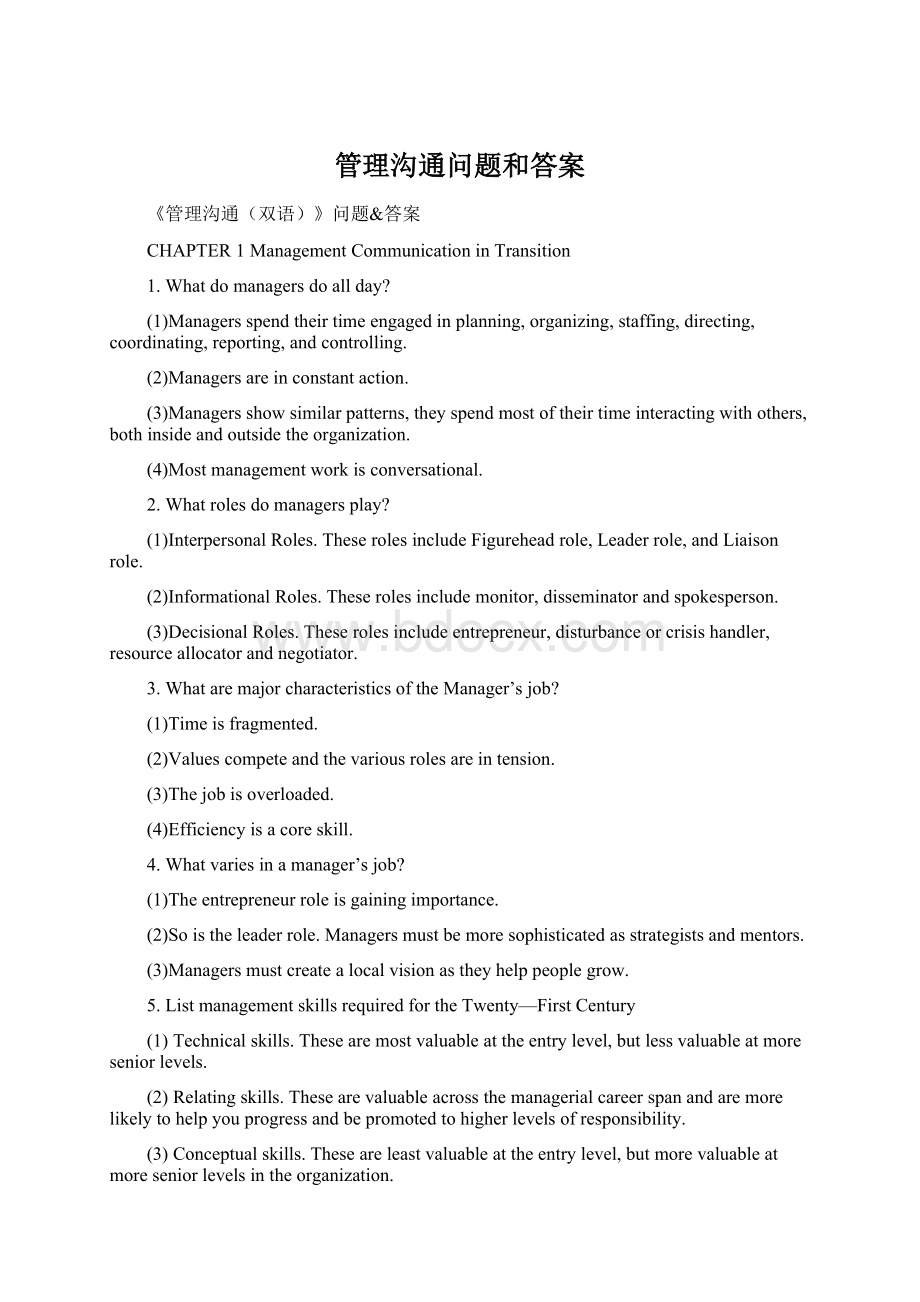管理沟通问题和答案.docx
《管理沟通问题和答案.docx》由会员分享,可在线阅读,更多相关《管理沟通问题和答案.docx(27页珍藏版)》请在冰豆网上搜索。

管理沟通问题和答案
《管理沟通(双语)》问题&答案
CHAPTER1ManagementCommunicationinTransition
1.Whatdomanagersdoallday?
(1)Managersspendtheirtimeengagedinplanning,organizing,staffing,directing,coordinating,reporting,andcontrolling.
(2)Managersareinconstantaction.
(3)Managersshowsimilarpatterns,theyspendmostoftheirtimeinteractingwithothers,bothinsideandoutsidetheorganization.
(4)Mostmanagementworkisconversational.
2.Whatrolesdomanagersplay?
(1)InterpersonalRoles.TheserolesincludeFigureheadrole,Leaderrole,andLiaisonrole.
(2)InformationalRoles.Theserolesincludemonitor,disseminatorandspokesperson.
(3)DecisionalRoles.Theserolesincludeentrepreneur,disturbanceorcrisishandler,resourceallocatorandnegotiator.
3.WhataremajorcharacteristicsoftheManager’sjob?
(1)Timeisfragmented.
(2)Valuescompeteandthevariousrolesareintension.
(3)Thejobisoverloaded.
(4)Efficiencyisacoreskill.
4.Whatvariesinamanager’sjob?
(1)Theentrepreneurroleisgainingimportance.
(2)Soistheleaderrole.Managersmustbemoresophisticatedasstrategistsandmentors.
(3)Managersmustcreatealocalvisionastheyhelppeoplegrow.
5.ListmanagementskillsrequiredfortheTwenty—FirstCentury
(1)Technicalskills.Thesearemostvaluableattheentrylevel,butlessvaluableatmoreseniorlevels.
(2)Relatingskills.Thesearevaluableacrossthemanagerialcareerspanandaremorelikelytohelpyouprogressandbepromotedtohigherlevelsofresponsibility.
(3)Conceptualskills.Theseareleastvaluableattheentrylevel,butmorevaluableatmoreseniorlevelsintheorganization.
6.Whatdoesverbalinteraction(talk)include?
(1)One—on—oneconversations.
(2)Telephoneconversations.
(3)Videoteleconferencing.
(4)Presentationstosmallgroups.
(5)Publicspeakingtolargeraudiences.
7.Whythemajorchannelsofmanagementcommunicationaretalkingandlistening
(1)Aseriesofscientificstudieshaveservedtoconfirmwhateachofusknowsthatmostmanagersspendthelargestportionoftheirdaytalkingandlistening.
(2)E.K.Werner’sthesisattheUniversityofMaryland,infact,foundthatNorthAmericanadultsspendmorethan78percentoftheircommunicationtimeeithertalkingorlisteningtootherswhoaretalking.
(3)AccordingtoWernerandotherswhohavestudiedthecommunicationhabitsofpostmodernbusinessorganizations,managersareinvolvedinmorethanjustspeechesandpresentationsfromthedaisorteleconference.
(4)Eachoftheseactivitiesmaylooktosomemanagerslikeanobligationimposedbythejob.
8.Whatroledoeswritingplay?
(1)Wittingisacareersifter.
(2)Managersdomostoftheirownwritingandediting.
(3)Documentstakeonlivesoftheirown.
9.Communicationisinvention,howdoyouunderstand?
(1)Withoutquestion,communicationisaprocessofinvention.
(2)Thefactis,managerscreatemeaningthroughcommunication.
(3)Additionally,itisimportanttonotethatmanagersusuallyfigurethingsoutbytalkingaboutthemasmuchastheytalkaboutthethingstheyhavealreadyfiguredout.
10.Whyinformationissociallyconstructed?
(1)Informationiscreated,shared,andinterpretedbypeople.
(2)Informationneverspeaksforitself.
(3)Contextalwaysdrivesmeaning.
(4)Amessengeralwaysaccompaniesmessage.
11.Whatisthegreatestchallengeforeverymanager?
Yourgreatestchallengeistoadmittoflawsinyourskillsetandworktirelesslytoimprovethem.Butfirst,youmustadmittotheflaws.
12.Whatisyourtaskasaprofessional?
(1)Asaprofessionalmanager,yourfirsttaskistorecognizeandunderstandyourstrengthsandweaknessesasacommunicator.
(2)Foremostamongyourgoalsshouldbetoimproveexistingskills.
(3)Twoothersuggestionscometomindforimprovingyourprofessionalstandingasamanager.Acquireaknowledgebasethatwillworkfortwenty—firstcentury.
(4)Youshouldreadatleastonenationalnewspapereachday.
(5)Yourfinalchallengeistodeveloptheconfidenceyouwillneedtosucceedasamanager.
CHAPTER2CommunicationsandStrategy
1.Definecommunication
(1)Communicationisthetransferofmeaning.
(2)Itmustbeunderstood.
(3)Itisacomplex,ongoingprocess.
2.Whataretheelementsofcommunication?
(1)Sender.
(2)Receiver.
(3)Message.
(4)Medium.
(5)Code.
(6)Feedback.
(7)Noise.
(8)Effect.
3.Whataretheprinciplesofcommunication?
(1)Dynamic.Humancommunicationisconstantlyundergoingchange.
(2)Continuous.Communicationneverstops.
(3)Circular.Communicationisrarelyeverentirelyone—way.
(4)Unrepeatable.
(5)Irreversible.
(6)Complex.
4.Whatarelevelsofcommunication?
(1)Intrapersonal.
(2)Interpersonal.
(3)Organizational.
(4)Massorpublic.
5.Whatarebarriersofcommunication?
(1)Physiologicalbarriers.Insendingmessagetoothers,wemustbesensitivetothefactthattheymaynotsee,hear,touch,smell,ortasteinthesamewaywedo.
(2)Psychologicalbarriers.Suchasfiltering,emotions,informationoverload,language,andnationalculture.
6.Howtocommunicatestrategically?
(1)Itmeansthatyourplansforcommunication,yourproposedmessages,themediumyouselect,thecodeyouemploy,thecontextandexperienceyoubringtosituation,andtheethicsyouadoptwillallhaveadirecteffectontheoutcome.
(2)Ifyouarecommunicatingstrategically,thosegoalswillbealignedwithanddirectlysupportthegoalsoftheorganizationyouworkfor.
(3)Youmustaskyourselfafewquestionsrelatedtotheelementsofcommunicationlistedabove.
7.Listthestepsofsuccessfulstrategiccommunication
(1)Linkyourmessagetothestrategyandgoalsoftheorganization.
(2)Attracttheattentionofyourintendedaudience.
(3)Explainyourpositionintermstheywillunderstandandaccept.
(4)Motivateyouraudiencetoacceptandactonyourmessage.
(5)Inoculatethemagainstcontrarymessageandpositions.
(6)Manageaudienceexpectations.
8.Whycommunicatingasamanagerisdifferent?
(1)Levelsofresponsibilityandaccountability.Thehigheryourlevelofresponsibilityinanorganization,themoreyouhavetothinkabout.
(2)Organizationaldynamics.Organizations,likethehumanswhopopulateandanimatethem,areinconstantflux.
(3)Personalitypreferences.Itisimportanttoacknowledgethateachofushashisorherownpreferenceforgathering,organizing,anddisseminatinginformation.
9.Whatarethetacticsofcommunication?
(1)fact—finding.
(2)Analysis.
(3)Methods.
(4)Timing.
(5)Media.
(6)Cost.
(7)Thedozensofassumptionsyoumustmakeaboutyouraudience,yourreasonsforcommunicatingandsoon.
CHAPTER3CommunicationEthics
1.Howtounderstandtheethicalconductofemployers?
(1)ArecentNationalBusinessEthicsSurveydiscoveredthatemployeescareabouttheethicalconducttheiremployers.
(2)ThroughHudson—Walkersurvey,onlyathirdofemployeesfeelcomfortablereportingmisconduct.30percentofemployeesknowofsuspectethicalviolationsintheirorganizationsinthepasttwoyears.
(3)Themajorityoftheseemployeeshaveseenorknowaboutaviolationhavenotreportedit.
(4)Ifyoubehaveinunethicalways,peoplewillquicklyrealizethatyoucannotbetrusted.
2.Definingbusinessethics
(1)Ethicsmostoftenreferstoafieldofinquiry,ordiscipline,inwhichmattersofrightandwrong,goodandevil,virtueandvice,aresystematicallyexamined.
(2)Moralityismostoftenusedtorefernottodisciplinebuttopatternsofbehaviorthatareactuallycommonineverydaylife.
(3)Socialresponsibilityreferstopartofethics,relatingtoexternalconstituencies.
(4)Theserelationshipsdefinealargeandveryimportantpartofbusinessethics.Businessethicsisamuchlargernotionthancorporatesocialresponsibity,eventhoughitincludesthatconcept.
3.Whatarethreelevelsofinquiry?
(1)Theindividual.Businessethicsconcernsthevaluesbywhichself—interestandothermotivesarebalancedwithconcernforfairnessandthecommongood,bothinsideandoutsideofacompany.
(2)Theorganization.Businessethicsconcernsthegroupconsciencethateverycompanyhasasitpursuesitseconomicobjectives.
(3)Theeconomy.Businessethicsconcernsthepatternofsocial,political,andeconomicforces.
4.Listthreeviewsofdecisionmaking
(1)Moralpointofview.Ithastwoimportantfeatures.Thefirstisawillingnesstoseekoutandactonreasons.Second,amoralpointofviewrequiresthedecisionmakertobeimpartial.
(2)Economicpointofview.
(3)Legalpointofview.
5.Howtounderstandanintegratedapproach?
Manybusinessethicistsadvocateadecision—makingprocessthatintegratesthesethreeviewpoints,consideringthedemandsofmorality,economics,andthelawtogether.Decisions,theysay,canbemadeonthebasisofmorality,profit,andlegalitytogethertoarriveatworkablesolutionswhichwilltakeintoaccountthebestinterestsofallconcerned,protecttheinvestmentofshareholders,andobeythelaw.
6.Whatarethetwobasictypesofjudgments?
(1)Twobasictypesofjudgmentsarenormativejudgmentsandmoraljudgments.
(2)Normativejudgmentsareclaimsthatstateorimplythatsomethingisgoodorbad,rightorwrong,betterorworse,oughttobeoroughtnotbe.
(3)Moraljudgments,then,areaspecialsubsetorcategoryofnormativejudgments.
(4)Businesspeopleusetwotypesofmoralstandardstomakedecisions.Oneismoralnorms,theotherismoralprinciples.
7.Howtodistinguishcharacteristicsofmoralprinciplesfromotherstandards?
(1)TheyhaveseriousconsequencestoHumanWell—Being.
(2)Theirvalidityrestsontheadequacyofthereasonswhichareusedtosupportandjustifythem.
(3)Theyoverride